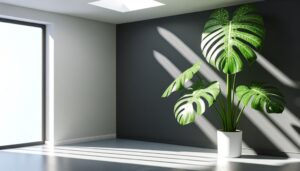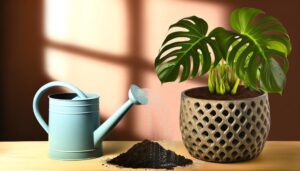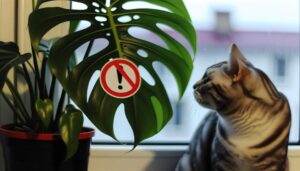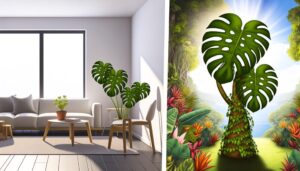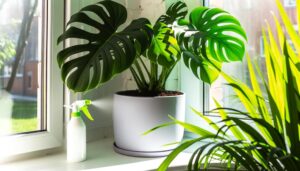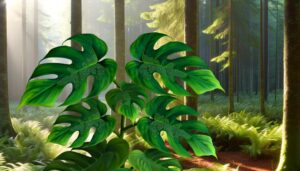Philodendron Cobra Vs Monstera Standleyana
When comparing Philodendron Cobra and Monstera Standleyana, you'll notice stark contrasts. Philodendron Cobra has narrow, lanceolate leaves with subtle variegation, while Monstera Standleyana showcases broader, oblong leaves and bold, irregular variegation due to chlorophyll mutation.
Philodendron Cobra grows compact and bushy with shorter internodes, while Monstera Standleyana favors a vining habit with elongated internodes and aerial roots. Both plants thrive in bright, indirect light and need well-draining soil.
However, Monstera Standleyana tolerates lower light levels. Both species demand consistent moisture without overwatering.
For intricate growth patterns and specific care tips, further details await.
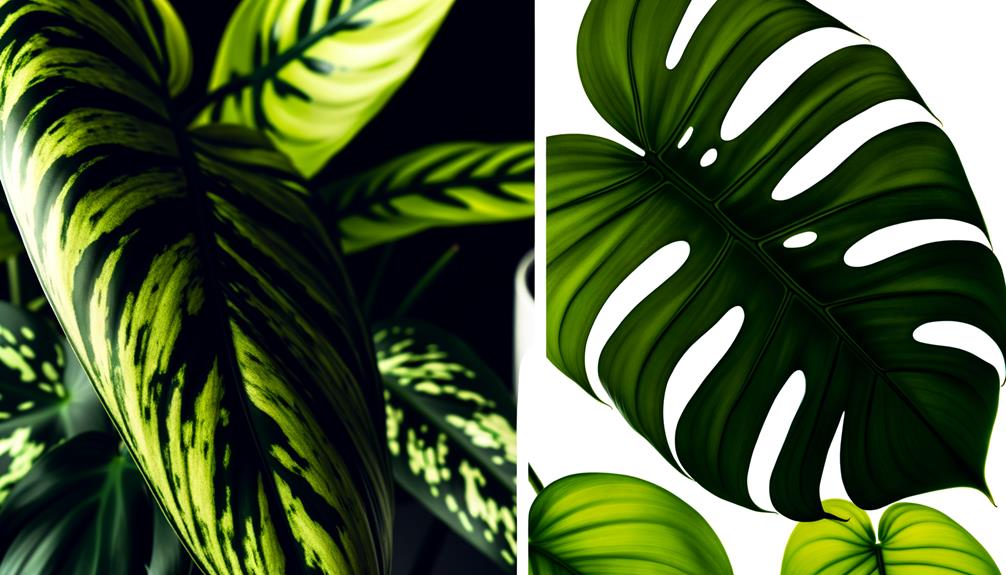
Key Takeaways
- Philodendron Cobra has narrow, lanceolate leaves, while Monstera Standleyana features broad, oblong leaves with bold, irregular variegation.
- Philodendron Cobra exhibits compact, bushy growth; Monstera Standleyana has a vining habit and benefits from support structures.
- Monstera Standleyana's variegation results from a mutation affecting chlorophyll production, creating a striking visual contrast.
- Philodendron Cobra prefers bright, indirect light, while Monstera Standleyana can tolerate lower light levels but needs consistent moisture.
- Both plants are susceptible to pests like spider mites and scale; prompt treatment with insecticidal soap or neem oil is essential.
Origins and Background
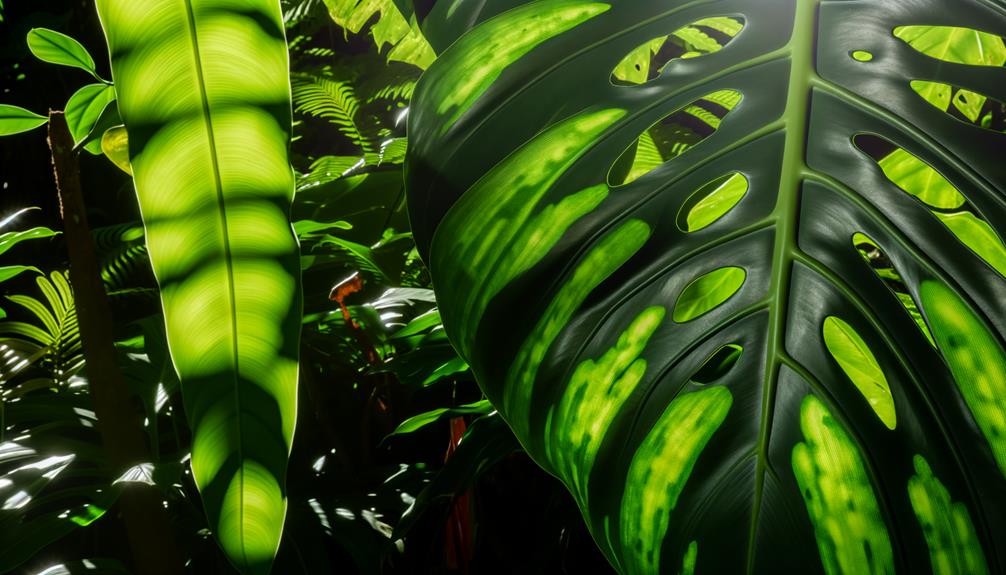
Both the Philodendron Cobra and Monstera Standleyana originate from the tropical rainforests of Central and South America, exhibiting distinct ecological adaptations.
You'll find that these plants thrive in humid, shaded environments, where they've developed strategies to maximize light absorption.
The Philodendron Cobra often climbs trees using its aerial roots, allowing it to reach higher light levels in the dense canopy.
On the other hand, Monstera Standleyana employs a similar climbing mechanism but is especially adept at spreading across forest floors and lower strata.
This climbing ability is crucial for both species to access light in their native habitats.
Understanding their origins highlights their resilience and specific adaptations to tropical rainforest ecosystems.
Foliage Characteristics
When comparing the foliage characteristics of Philodendron Cobra and Monstera Standleyana, you'll notice distinct differences in leaf shape and variegation patterns.
Philodendron Cobra exhibits elongated, lanceolate leaves, while Monstera Standleyana features more oblong, paddle-shaped leaves.
Additionally, the variegation in Philodendron Cobra tends to be more subtle and uniform, contrasting with the bold, irregular variegation of Monstera Standleyana.
Leaf Shape Comparison
In examining the leaf shapes of Philodendron Cobra and Monstera Standleyana, you'll notice that Philodendron Cobra features elongated, lanceolate leaves, while Monstera Standleyana boasts broader, oblong leaves often adorned with striking variegation. This fundamental difference in leaf morphology impacts their overall aesthetic and growth patterns. Philodendron Cobra's lanceolate leaves give it a sleek, elongated appearance, enhancing its vertical growth. Conversely, Monstera Standleyana's oblong leaves contribute to a fuller, more robust look. Understanding these distinctions helps you appreciate both plants' unique beauty and informs your choice based on spatial considerations.
| Characteristic | Philodendron Cobra | Monstera Standleyana |
|---|---|---|
| Leaf Shape | Lanceolate | Oblong |
| Leaf Width | Narrow | Broad |
| Leaf Length | Long | Moderately Long |
| Visual Impact | Sleek, Vertical | Full, Robust |
Variegation Patterns Analysis
Examining the variegation patterns of Philodendron Cobra and Monstera Standleyana, you'll find that Philodendron Cobra's foliage typically lacks variegation, whereas Monstera Standleyana often showcases striking, irregular patches of creamy white on its leaves.
Monstera Standleyana's variegation results from a mutation that disrupts chlorophyll production, causing areas of white tissue. This variegation isn't uniform; it can appear as splotches, streaks, or marbling.
In contrast, the Philodendron Cobra maintains a more consistent green coloration, which can be attributed to its stable chlorophyll synthesis. The lack of variegation in Philodendron Cobra means it may photosynthesize more efficiently than the variegated Monstera Standleyana.
Understanding these patterns helps in identifying and caring for these unique plants.
Growth Patterns

Philodendron Cobra exhibits a more compact and bushy growth pattern compared to the taller, vining habit of Monstera Standleyana. You'll notice that Philodendron Cobra's internodes are shorter, resulting in denser foliage. This compact structure makes it ideal for smaller spaces or tabletop displays. The plant's aerial roots are less pronounced, reflecting its preference for a more grounded growth habit.
In contrast, Monstera Standleyana features elongated internodes and vigorous climbing tendencies. You'll find it thriving when given a support structure like a moss pole or trellis. Its growth pattern includes the development of aerial roots that can latch onto surfaces, facilitating vertical expansion. This vining characteristic is well-suited for larger spaces or hanging displays, providing an elegant, cascading appearance.
Light and Water Needs
When considering light and water requirements, you'll find that Philodendron Cobra prefers bright, indirect light, while Monstera Standleyana thrives in similar conditions but can tolerate lower light levels.
Both species need consistent moisture, yet it's vital to let the top inch of soil dry out between waterings to prevent root rot.
Monitoring these factors guarantees ideal growth and prevents common issues.
Optimal Light Conditions
To promote healthy growth, both Philodendron Cobra and Monstera Standleyana require bright, indirect light, though they can tolerate lower light levels. Make sure you place them near windows with filtered light to mimic their natural tropical habitat. Avoid direct sunlight, which can scorch their leaves, leading to discoloration and damage.
Here's a quick comparison to help you understand their light needs better:
| Plant | Light Tolerance | Ideal Conditions |
|---|---|---|
| Philodendron Cobra | Low to Medium | Bright, Indirect Light |
| Monstera Standleyana | Low to Medium | Bright, Indirect Light |
| Direct Sunlight | Not Preferred | Filtered Light Only |
| Leaf Color | Can Fade | Vibrant Under Ideal |
| Growth Rate | Slows in Low | Robust in Best |
Positioning your plants correctly guarantees vibrant foliage and strong growth.
Watering Frequency Tips
Maintaining proper watering frequency is crucial for the health of both Philodendron Cobra and Monstera Standleyana, as overwatering or underwatering can significantly impact their growth.
For Philodendron Cobra, water when the top inch of soil feels dry. Overwatering can lead to root rot, so make sure the pot has adequate drainage.
Monstera Standleyana prefers slightly more moisture; water when the top 1-2 inches of soil are dry. Always use room temperature water to avoid shock.
Both plants benefit from a consistent watering schedule, adjusted seasonally. In winter, reduce watering frequency as growth slows. Always monitor soil moisture using a moisture meter for precision.
This approach ensures both species thrive, maintaining ideal hydration without risk of water stress.
Soil and Potting

Proper soil composition and potting techniques are essential for the best growth of both Philodendron Cobra and Monstera Standleyana. Use a well-draining soil mix, combining equal parts of peat moss, perlite, and orchid bark. This guarantees sufficient aeration and prevents root rot.
For potting, select containers with drainage holes to avoid water accumulation. Aim to repot every 1-2 years, upgrading to a slightly larger pot as roots outgrow the current one. When potting, gently loosen the root ball to promote new growth. Avoid compacting the soil too firmly, as this can impede root expansion.
Maintain soil pH between 5.5 and 6.5 for peak nutrient absorption. Regularly check for root health and amend the soil if you notice any compaction or poor drainage.
Propagation Methods
There are several effective methods for propagating Philodendron Cobra and Monstera Standleyana, with stem cuttings being the most common approach.
You can achieve successful propagation by following these steps:
- Stem Cuttings: Use sterilized scissors to cut a healthy stem with at least one node and an aerial root. Place the cutting in water or moist soil until roots develop.
- Air Layering: Wrap a section of the stem with moist sphagnum moss and plastic wrap. Once roots form, cut below the rooted section and plant it.
- Division: Carefully separate the root ball during repotting, ensuring each section has roots and stems, then plant each division in separate pots.
These methods promote robust growth and a healthy plant.
Common Pests and Issues
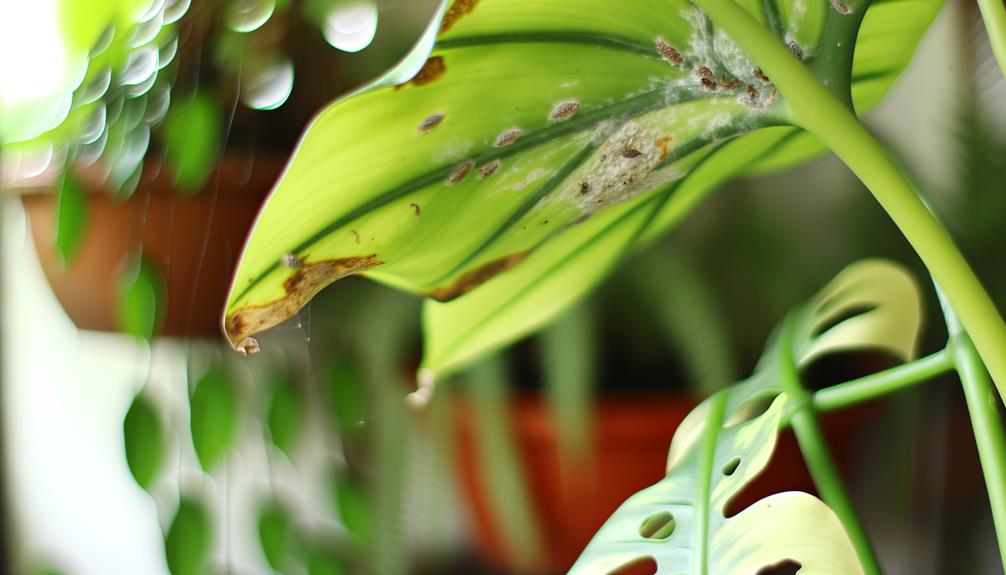
Why do Philodendron Cobra and Monstera Standleyana often fall prey to pests like spider mites, aphids, and scale, which can cause significant damage if not promptly addressed? These plants' broad leaves and high moisture preference create an ideal environment for pests. Regular inspection and prompt action are vital to maintain plant health.
Here's a quick reference to common pests and issues:
| Pest | Symptoms |
|---|---|
| Spider Mites | Fine webbing, yellowing leaves |
| Aphids | Sticky residue, curled leaves |
| Scale | Brown scales, yellowing spots |
| Mealybugs | White cotton-like masses, stunted growth |
Combat these pests with insecticidal soap or neem oil, and ensure proper air circulation and humidity levels. Regular monitoring will help catch infestations early.
Conclusion
In your quest for the perfect climbing houseplant, think of Philodendron Cobra and Monstera Standleyana as the Montagues and Capulets of the plant world. Both offer unique foliage, distinct growth habits, and specific care requirements.
With a little understanding of their preferences—light, water, soil—you'll cultivate a verdant kingdom. Choose wisely, and you'll find either plant rewarding, turning your living space into a botanical masterpiece, much like the lush gardens of Babylon.

